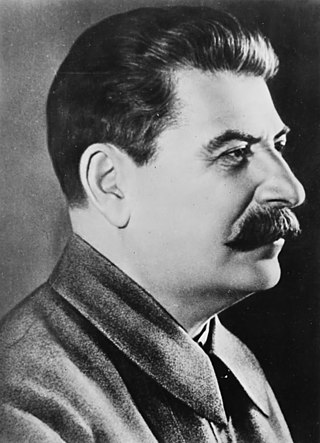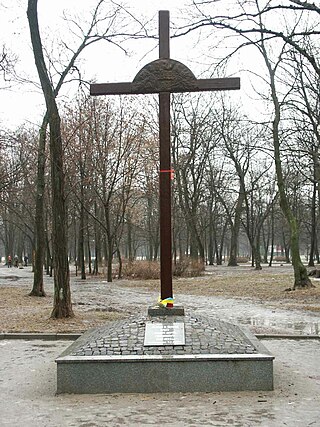
Stalinism is the means of governing and Marxist–Leninist policies implemented in the Soviet Union (USSR) from 1927 to 1953 by Joseph Stalin. It included the creation of a one-party totalitarian police state, rapid industrialization, the theory of socialism in one country, collectivization of agriculture, intensification of class conflict, a cult of personality, and subordination of the interests of foreign communist parties to those of the Communist Party of the Soviet Union, which Stalinism deemed the leading vanguard party of communist revolution at the time. After Stalin's death and the Khrushchev Thaw, a period of de-Stalinization began in the 1950s and 1960s, which caused the influence of Stalin's ideology to begin to wane in the USSR.

The Soviet Union introduced the collectivization of its agricultural sector between 1928 and 1940 during the ascension of Joseph Stalin. It began during and was part of the first five-year plan. The policy aimed to integrate individual landholdings and labour into nominally collectively-controlled and openly or directly state-controlled farms: Kolkhozes and Sovkhozes accordingly. The Soviet leadership confidently expected that the replacement of individual peasant farms by collective ones would immediately increase the food supply for the urban population, the supply of raw materials for the processing industry, and agricultural exports via state-imposed quotas on individuals working on collective farms. Planners regarded collectivization as the solution to the crisis of agricultural distribution that had developed from 1927. This problem became more acute as the Soviet Union pressed ahead with its ambitious industrialization program, meaning that more food would be needed to keep up with urban demand.

The Holodomor, also known as the Ukrainian Famine, was a man-made famine in Soviet Ukraine from 1932 to 1933 that killed millions of Ukrainians. The Holodomor was part of the wider Soviet famine of 1930–1933 which affected the major grain-producing areas of the Soviet Union.

Agriculture in the Soviet Union was mostly collectivized, with some limited cultivation of private plots. It is often viewed as one of the more inefficient sectors of the economy of the Soviet Union. A number of food taxes were introduced in the early Soviet period despite the Decree on Land that immediately followed the October Revolution. The forced collectivization and class war against "kulaks" under Stalinism greatly disrupted farm output in the 1920s and 1930s, contributing to the Soviet famine of 1932–33. A system of state and collective farms, known as sovkhozes and kolkhozes, respectively, placed the rural population in a system intended to be unprecedentedly productive and fair but which turned out to be chronically inefficient and lacking in fairness. Under the administrations of Nikita Khrushchev, Leonid Brezhnev, and Mikhail Gorbachev, many reforms were enacted as attempts to defray the inefficiencies of the Stalinist agricultural system. However, Marxist–Leninist ideology did not allow for any substantial amount of market mechanism to coexist alongside central planning, so the private plot fraction of Soviet agriculture, which was its most productive, remained confined to a limited role. Throughout its later decades the Soviet Union never stopped using substantial portions of the precious metals mined each year in Siberia to pay for grain imports, which has been taken by various authors as an economic indicator showing that the country's agriculture was never as successful as it ought to have been. The real numbers, however, were treated as state secrets at the time, so accurate analysis of the sector's performance was limited outside the USSR and nearly impossible to assemble within its borders. However, Soviet citizens as consumers were familiar with the fact that foods, especially meats, were often noticeably scarce, to the point that not lack of money so much as lack of things to buy with it was the limiting factor in their standard of living.

Throughout Russian history famines, droughts and crop failures occurred on the territory of Russia, the Russian Empire and the USSR on more or less regular basis. From the beginning of the 11th to the end of the 16th century, on the territory of Russia for every century there were 8 crop failures, which were repeated every 13 years, sometimes causing prolonged famine in a significant territory. The causes of the famine were different, from natural and economic and political crises; for example, the Great Famine of 1931–1933, colloquially called the Holodomor, the cause of which was the collectivization policy in the USSR, which affected the territory of the Volga region in Russia, Ukraine and Kazakhstan.
Throughout the history of the Soviet Union, tens of millions of people suffered political repression, which was an instrument of the state since the October Revolution. It culminated during the Stalin era, then declined, but it continued to exist during the "Khrushchev Thaw", followed by increased persecution of Soviet dissidents during the Brezhnev era, and it did not cease to exist until late in Mikhail Gorbachev's rule when it was ended in keeping with his policies of glasnost and perestroika.

The first five-year plan of the Union of Soviet Socialist Republics (USSR) was a list of economic goals, implemented by Communist Party General Secretary Joseph Stalin, based on his policy of socialism in one country. Leon Trotsky had delivered a joint report to the April Plenum of the Central Committee in 1926 which proposed a program for national industrialisation and the replacement of annual plans with five-year plans. His proposals were rejected by the Central Committee majority which was controlled by the troika and derided by Stalin at the time. Stalin's version of the five-year plan was implemented in 1928 and took effect until 1932.

The Soviet famine of 1930–1933 was a famine in the major grain-producing areas of the Soviet Union, including Ukraine and different parts of Russia, including Northern Caucasus, Kuban Region, Volga Region, Kazakhstan, the South Urals, and West Siberia. Major causes include: the forced collectivization of agriculture as a part of the First Five-Year Plan and forced grain procurement from farmers. These factors in conjunction with a massive investment in heavy industry decreased the agricultural workforce. Estimates conclude that 5.7 to 8.7 million people died of hunger across the Soviet Union.

Dekulakization was the Soviet campaign of political repressions, including arrests, deportations, or executions of millions of kulaks and their families. Redistribution of farmland started in 1917 and lasted until 1933, but was most active in the 1929–1932 period of the first five-year plan. To facilitate the expropriations of farmland, the Soviet government announced the "liquidation of the kulaks as a class" on 27 December 1929, portraying kulaks as class enemies of the Soviet Union.

In 1932–1933, a man-made famine, known as the Holodomor, killed 3.3–5 million people in the Ukrainian Soviet Socialist Republic, included in a total of 5.5–8.7 million killed by the broader Soviet famine of 1930–1933. At least 3.3 million ethnic Ukrainians died as a result of the famine in the USSR. Scholars debate whether there was an intent to starve millions of Ukrainians to death or not.

Collectivization in Ukraine, officially the Ukrainian Soviet Socialist Republic, was part of the policy of collectivization in the USSR and dekulakization that was pursued between 1928 and 1933 with the purpose to consolidate individual land and labour into collective farms called kolkhoz and to eliminate enemies of the working class. The idea of collective farms was seen by peasants as a revival of serfdom.
Repression in the Soviet Union was an ongoing characteristic of the state throughout the history of the Soviet Union, characterized by restricting the freedoms of the common man for the benefit of the communist state, albeit through a variety of means. Millions of the proletariat class experienced some form of repression from the state, stemming back to the October Revolution and the nature of totalitarianism. Repression culminated during the Stalin era, and marginally receded in the period after amidst De-Stalinization, but continued throughout the Soviet Union's existence up until late in the rule of Mikhail Gorbachev, the last leader of the Soviet Union.

The causes of the Holodomor, which was a famine in Soviet Ukraine during 1932 and 1933, resulted in the death of around 3–5 million people. The factors and causes of the famine are the subject of scholarly and political debate, which include the Holodomor genocide question. Soviet historians, Stephen Wheatcroft and J. Arch Getty believe the famine was the unintended consequence of problems arising from Soviet agricultural collectivization which were designed to accelerate the program of industrialization in the Soviet Union under Joseph Stalin. Other academics conclude policies were intentionally designed to cause the famine. Some scholars and political leaders claim that the famine may be classified as a genocide under the definition of genocide that entered international law with the 1948 Genocide Convention.
The Soviet famine of 1946–1947 was a major famine in the Soviet Union that lasted from mid-1946 to the winter of 1947 to 1948.

Blacklisting, or the system of the chorna doshka synonymous with a "board of infamy", was one of the elements of agitation-propaganda in the Soviet Union, and especially Ukraine and the Kuban region in the 1930s, and is considered as one of the instruments of the Holodomor. Blacklisting was also used in Soviet Kazakhstan. Eventually it transformed into a means of repression of peasants.

Collective farming and communal farming are various types of "agricultural production in which multiple farmers run their holdings as a joint enterprise". There are two broad types of communal farms: agricultural cooperatives, in which member-owners jointly engage in farming activities as a collective; and state farms, which are owned and directly run by a centralized government. The process by which farmland is aggregated is called collectivization. In some countries, there have been both state-run and cooperative-run variants. For example, the Soviet Union had both kolkhozy and sovkhozy.

Kulak, also kurkul or golchomag, was the term which was used to describe peasants who owned over 8 acres of land towards the end of the Russian Empire. In the early Soviet Union, particularly in Soviet Russia and Azerbaijan, kulak became a vague reference to property ownership among peasants who were considered hesitant allies of the Bolshevik Revolution. In Ukraine during 1930–1931, there also existed a term of podkulachnik ; these were considered "sub-kulaks".

The Kazakh famine of 1930–1933, also known as the Asharshylyk, was a famine during which approximately 1.5 million people died in the Kazakh Autonomous Socialist Soviet Republic, then part of the Russian Socialist Federative Soviet Republic in the Soviet Union, of whom 1.3 million were ethnic Kazakhs. An estimated 38 to 42 percent of all Kazakhs died, the highest percentage of any ethnic group killed by the Soviet famine of 1930–1933. Other research estimates that as many as 2.3 million died. A committee created by the Kazakhstan parliament chaired by Historian Manash Kozybayev concluded that the famine was "a manifestation of the politics of genocide", with 1.75 million victims.

Estimates of the number of deaths attributable to the Soviet revolutionary and dictator Joseph Stalin vary widely. The scholarly consensus affirms that archival materials declassified in 1991 contain irrefutable data far superior to sources used prior to 1991, such as statements from emigres and other informants.
Gigant is a sovkhoz located in the rural locality of Gigant in Salsky District of Rostov Oblast, Russia. The Gigant was the first grain sovkhoz.













